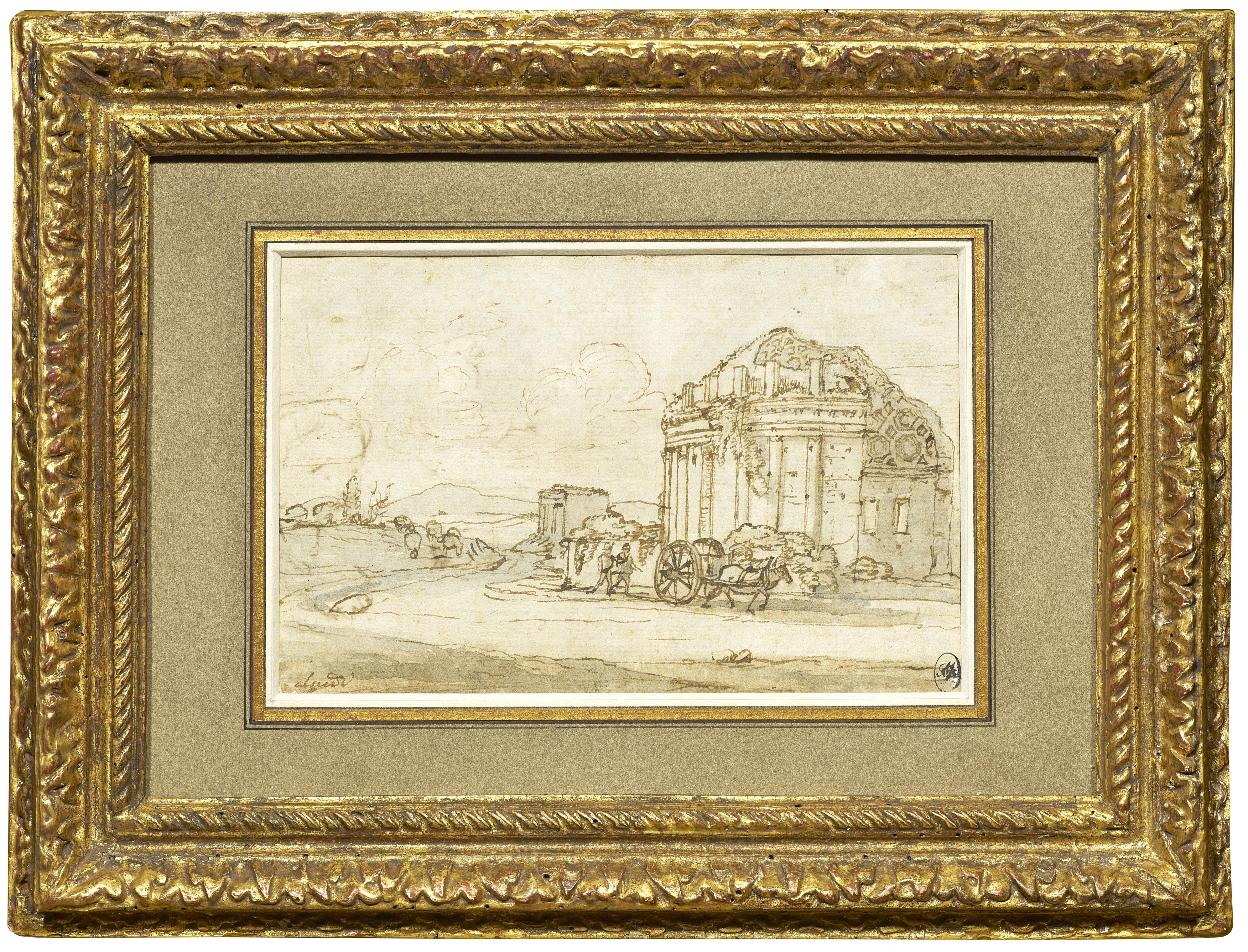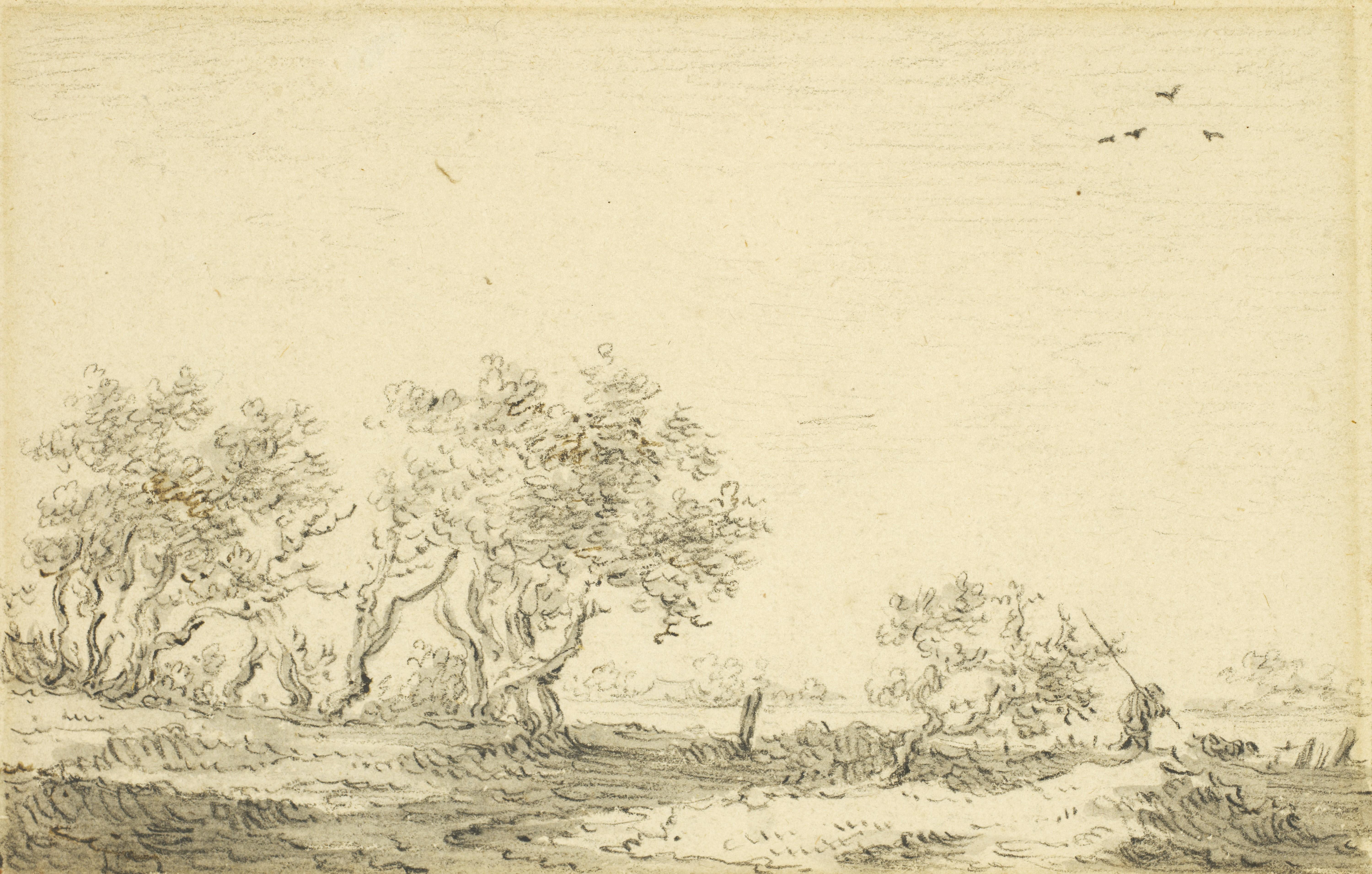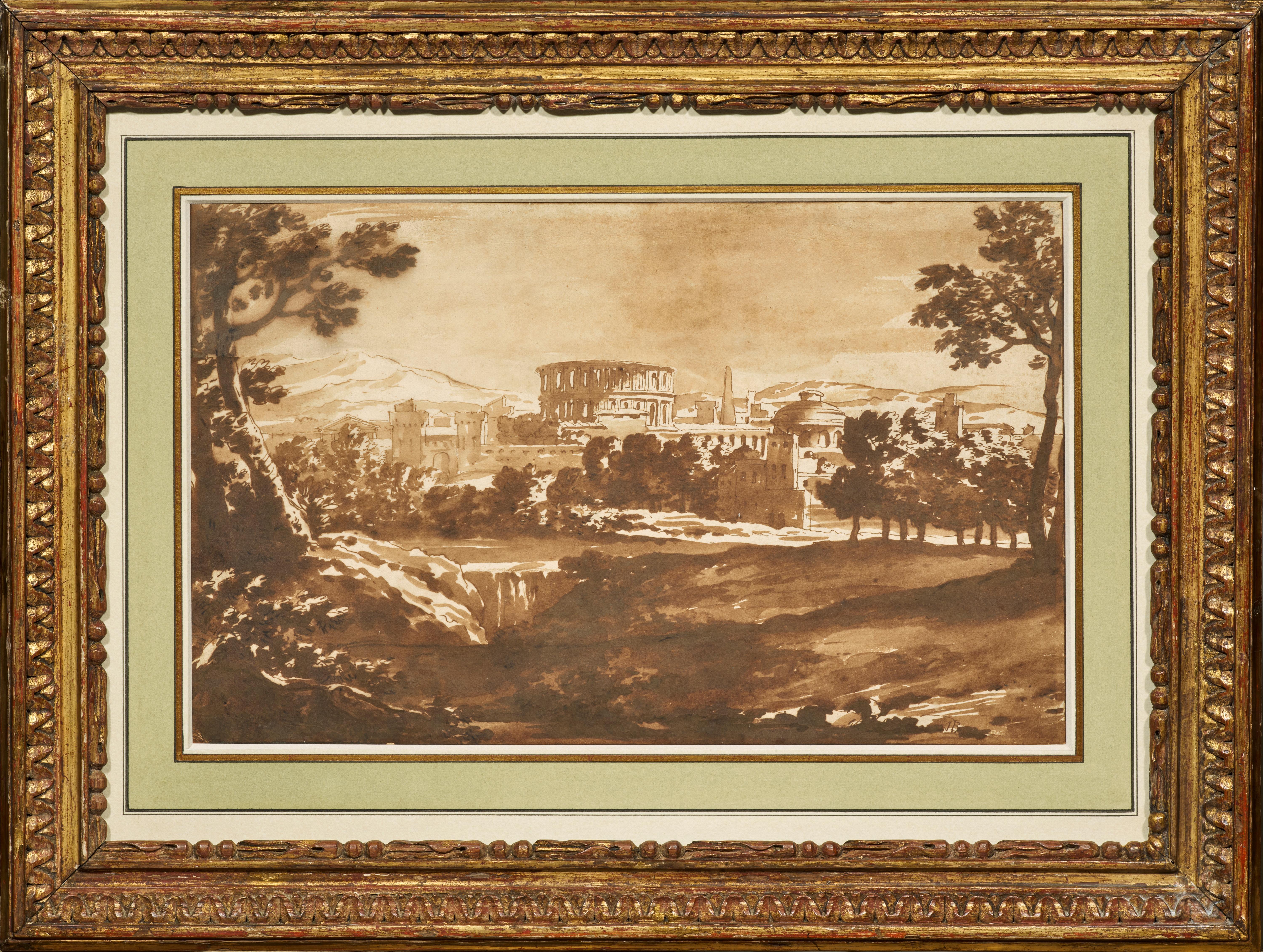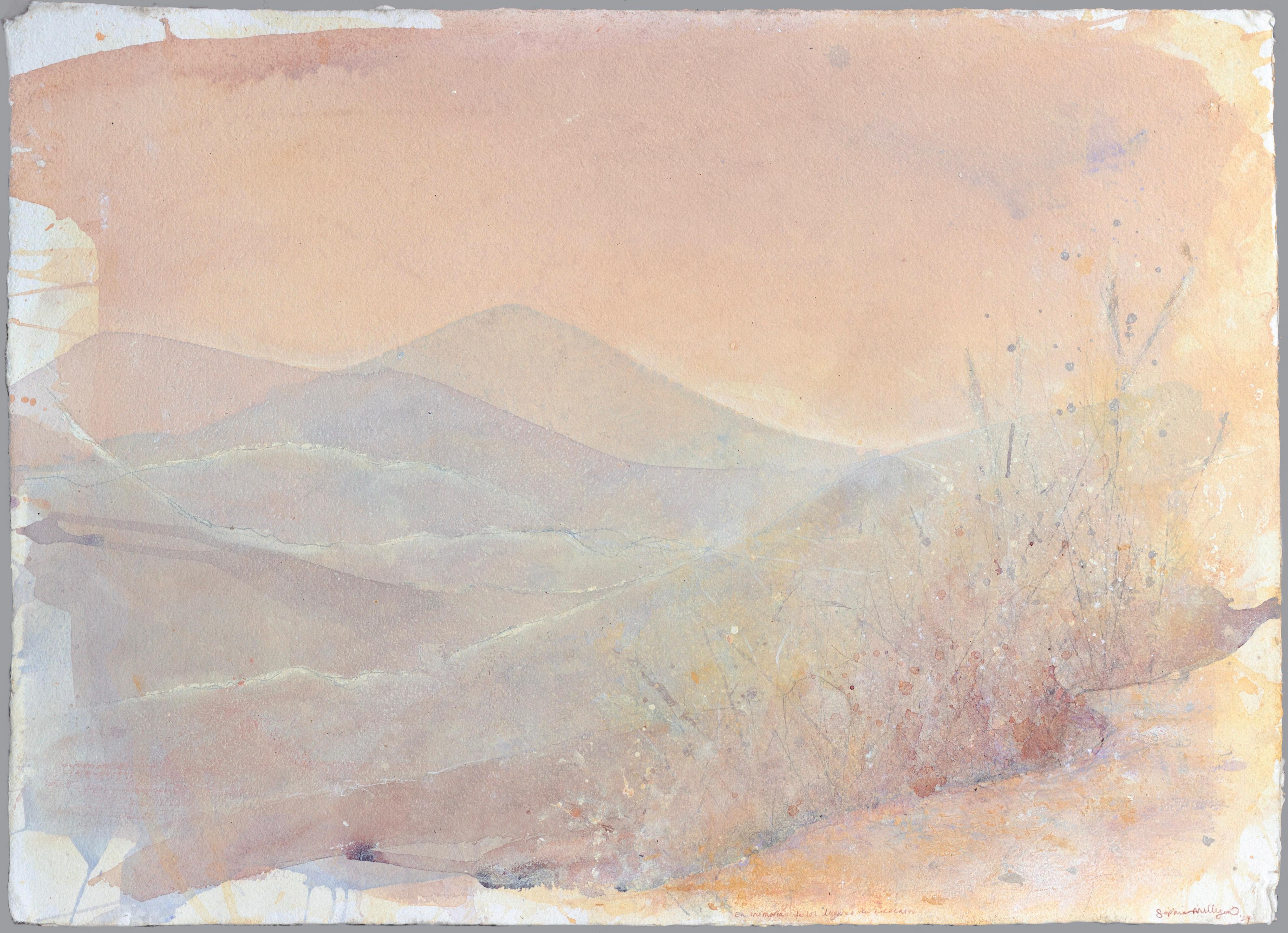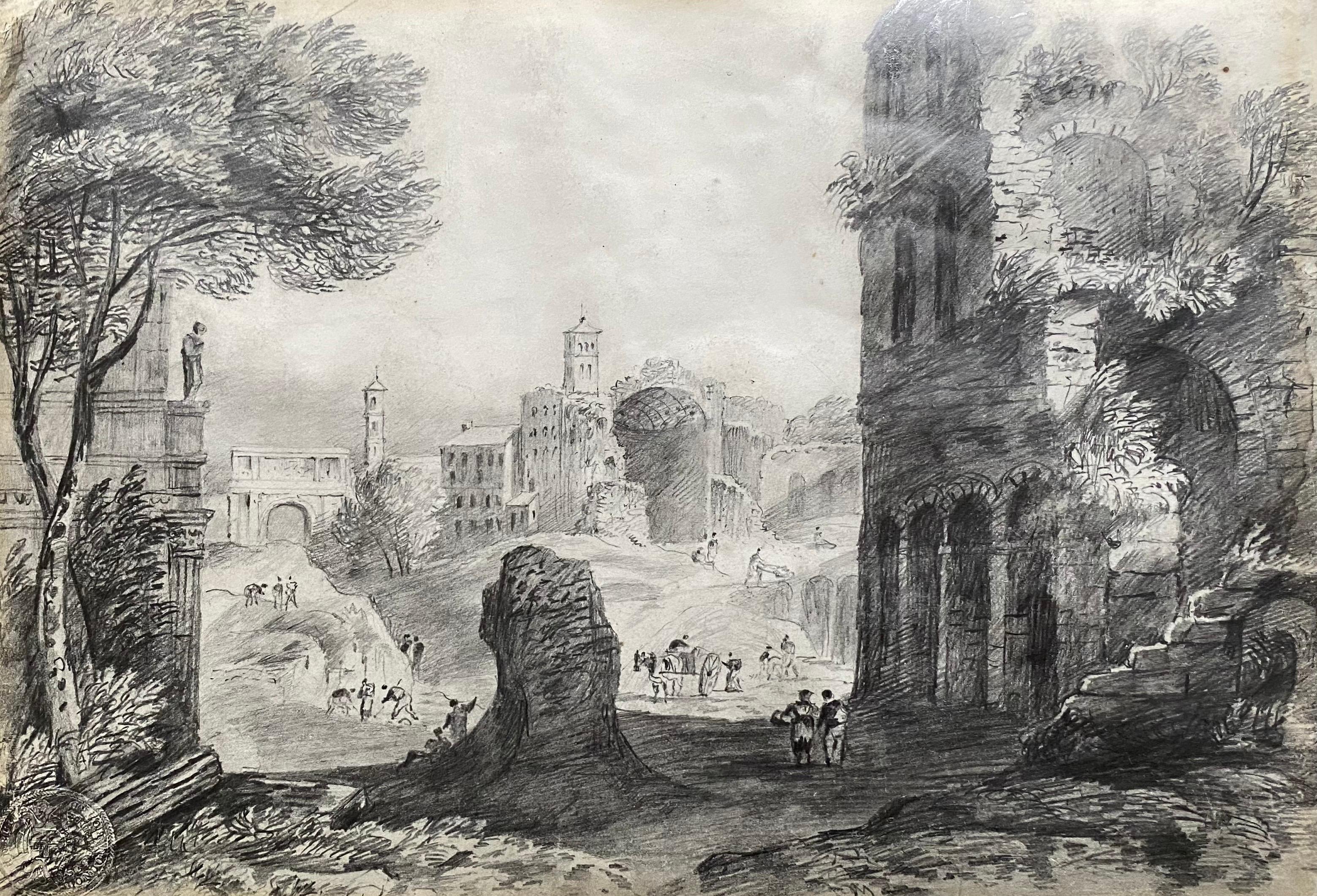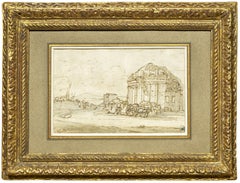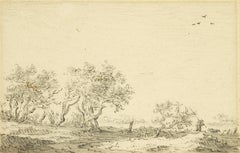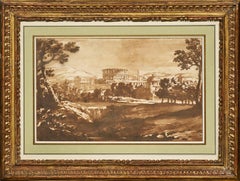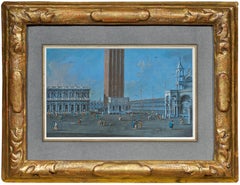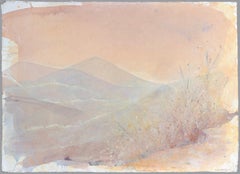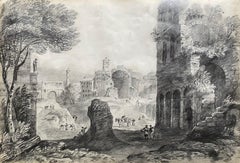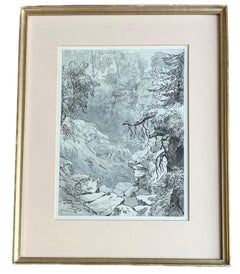Items Similar to View of a Mansion in the South of France, a drawing by Claude-Joseph Vernet
Want more images or videos?
Request additional images or videos from the seller
1 of 9
Claude-Joseph VernetView of a Mansion in the South of France, a drawing by Claude-Joseph Vernet1732-1734
1732-1734
About the Item
We would like to thank Madame Beck-Saiello for confirming the autograph nature of this drawing after an in-person examination.
It was probably during an excursion in the countryside near Avignon that Claude-Joseph Vernet executed this drawing, enhanced with pen and brown ink, depicting a mansion on a hilltop overlooking a small village with geometric shapes.
1. Joseph Vernet, a painter influenced by Italy
Claude-Joseph Vernet was born in Avignon in 1714, the son of Antoine Vernet (1689-1753), an artisan painter of architectural decorations, coach panels, and the like. He moved to the studio of Philippe Sauvan (1697-1792), a leading history painter in Avignon, and then worked with Jacques Viali (active 1681-1745), a decorative, landscape, and marine painter in Aix-en-Provence. Vernet's first recorded paintings were decorative overdoors executed in 1731 in the Aix townhouse of the marquise de Simiane. In 1734, Joseph de Seytres, marquis de Caumont, a leading amateur in Avignon, sponsored Vernet to make a study trip to Italy to complete his artistic education and to draw antiquities for his patron.
As Avignon was a papal territory in Vernet's day, he also had a number of useful introductions among influential churchmen when he arrived in Rome. Vernet was soon at home in the French community there, and he was encouraged by Nicolas Vleughels (1668-1737), director of the Académie de France in Rome, even though the young painter had no official affiliation with the royal institution. He likely entered the studio of the French marine painter Adrien Manglard (1695-1760). By 1740 Vernet was developing an independent reputation as a painter of topographical landscape in and around Rome and Naples, as well as of imaginary Italianate landscapes and marines, demonstrated by the increasing number of entries in his surviving account books from the mid-1730s onward. His first important patron in Rome was the French ambassador Paul Hippolyte de Beauvillier, duc de Saint-Aignan (1684-1776). This relationship set a pattern, and members of the French diplomatic corps and visiting French prelates remained important patrons during Vernet's long Roman sojourn, which lasted almost twenty years (he returned definitively to France in 1753). He also worked for the Roman nobility but it was the British - the wealthiest travelers in Europe - who became Vernet's main patrons during their Grand Tours, purchasing Italianate landscapes and marines as souvenirs of their visits to Italy. The British remained enthusiastic patrons of Vernet, even long after his return to France.
The appeal of Vernet's art was twofold. On the one hand, he drew on the tradition of ideal landscape painting codified by Claude Lorrain (1604/1605-1682) and Nicolas Poussin (1594-1665) in seventeenth-century Italy. Vernet, on the other hand, brought to the study of nature a more empirical and closely observed approach, consistent with his times, creating a more vivid and convincing impression of nature. Having established these kinds of paintings as successful formulas by the mid-1740s, Vernet continued to supply a European demand for them for the rest of his career.
Vernet first exhibited typical landscapes and marines at the Paris Salon of 1746, the year his membership in the Académie royale de peinture et de sculpture was approved. He became a full member in 1753 and exhibited successfully at the Salon for the rest of his life. He had come to the attention of Louis XV's administration in 1746, and in 1753 he was finally called back to France to begin an official commission to paint large topographical views of the principal commercial and military seaports of the realm. This commission took him on an arduous itinerary, from Antibes in the south to Dieppe in the north, from 1753 until 1765, during which time he completed fifteen large paintings. Vernet's "Ports of France" (Paris, Musée du Louvre on loan to the Musée de la Marine) are among the greatest French paintings of the mid-eighteenth century, for they are both remarkable social and historical documents, full of fascinating observation, and at the same time beautifully composed and rendered works of art.
Vernet continued a large production of imaginary landscape and marine paintings until his death on the eve of the French Revolution in 1789.
2. Description of the drawing
Our drawing was probably first executed by Claude-Joseph Vernet in pencil, working on the spot and in the open air, then retouched in pen and brown ink with a lively, regular stroke once he had returned to his studio. In all likelihood, it depicts a Provencal mansion, proudly perched on a hill overlooking a small village . The absence of shadows in the landscape and the cloudless sky allow us to imagine the bright mid-day sun.
The artist pays particular attention to the representation of architectural details (battlements, machicolations at the top of the towers, etc.). He is sensitive to the articulation of the geometric volumes that make up the village houses below the castle, and to the contrast between these sharp angles and the roundness of the castle towers. The trees are soberly evoked by their foliage, a characteristic found in many of Vernet's landscape drawings.
Vernet remained faithful to the pen-and-pencil technique for his figure drawings, as can be seen, for example, in the drawing of Trois hommes autour d'une grosse pierre (Three Men around a large Stone) in the Musée du Louvre.
From the middle of his Italian sojourn, his landscape drawings were often enriched by delicate wash work, leading us to consider this drawing a youthful work, probably executed before his departure for Italy.
3. Framing
Our drawing is soberly framed in a gilded wooden moulding reminiscent of the pastel frames of the Louis XV period.
Main bibliographical references :
Léon Lagrange - Joseph Vernet - Didier & Cie 1864
Florence Ingersoll-Smouse - Joseph Vernet, Peintre de Marine - Etienne Bignou 1926
Catalog of the exhibition Joseph Vernet 1714 - 1789 - Musée de la Marine, Paris (October 15, 1976 - January 9, 1977)
Emilie Beck Saiello - Napoli e la Francia - I Pittori da paesaggio da Vernet a Valenciennes - L'erma di Bretschneider, Roma 2010
- Creator:Claude-Joseph Vernet (1714 - 1789, French)
- Creation Year:1732-1734
- Dimensions:Height: 13 in (33.02 cm)Width: 19.5 in (49.53 cm)
- Medium:
- Movement & Style:
- Period:1730-1739
- Condition:Pen and brown ink over pencil lines Dimensions : 8 5/8’’ x 15 ½” (22 x 39.5 cm) - Framed : 13’’ x 19 ½’’ (33 x 49.5 cm) Louis XV style pastel frame in moulded and gilded wood.
- Gallery Location:PARIS, FR
- Reference Number:1stDibs: LU1568216242602
About the Seller
5.0
Vetted Professional Seller
Every seller passes strict standards for authenticity and reliability
Established in 2020
1stDibs seller since 2021
9 sales on 1stDibs
- ShippingRetrieving quote...Shipping from: PARIS, France
- Return Policy
Authenticity Guarantee
In the unlikely event there’s an issue with an item’s authenticity, contact us within 1 year for a full refund. DetailsMoney-Back Guarantee
If your item is not as described, is damaged in transit, or does not arrive, contact us within 7 days for a full refund. Details24-Hour Cancellation
You have a 24-hour grace period in which to reconsider your purchase, with no questions asked.Vetted Professional Sellers
Our world-class sellers must adhere to strict standards for service and quality, maintaining the integrity of our listings.Price-Match Guarantee
If you find that a seller listed the same item for a lower price elsewhere, we’ll match it.Trusted Global Delivery
Our best-in-class carrier network provides specialized shipping options worldwide, including custom delivery.More From This Seller
View AllA landscape drawing by Claude Lorrain, with a preliminary sketch on the verso
By Claude Lorrain
Located in PARIS, FR
This study presents a typical Roman countryside landscape: an ancient mausoleum in front of which a cart is passing by followed by two peasants. If the technique (a pen drawing on graphite lines, completed with a wash of brown and grey inks) and the signature inevitably evoke the art of Lorrain, we find on the verso of this drawing additional evidences that lead us to consider this unpublished drawing as a work by the master.
The motif of the mausoleum has been taken up in pen on the verso in a technique that can be found in several other drawings by Lorrain. There is also a study of three characters, which can be considered as preparatory to Lorrain’s painting entitled The Port of Ostia with the Embarkation of Saint Paula, leading us to claim this attribution with a dating of around 1639.
1. Claude Lorrain or the perfection of classical landscape in Rome in the 17th century
Claude Gellée was born in 1600 in Chamagne in Lorraine. Orphaned at the age of twelve, he spent a year with his brother in Freiburg, where the latter was a woodcarver. Claude Gellée then probably arrived in Rome in 1613, where he joined the workshop of Agostino Tassi (1580 - 1644) in 1617. Between 1619 and 1620 he studied for two years in Naples in the workshop of Goffredi Wals (who was himself a former pupil of Tassi).
In 1625 he returned to Lorraine for two years where he worked alongside Claude Deruet. He then returned to Rome, a city he never left for the rest of his life (except for short trips to the surrounding countryside).
From 1627 to 1650 he lived in Via Margutta. From 1635 onwards he became a renowned painter and commissions started to pour in. Considered during his lifetime as the most accomplished of the classical landscape painters, his reputation never faded.
Between 1629 and 1635 Le Lorrain often went to the Roman countryside to draw with his friend Joachim von Sandrart (1606 - 1686). He became a member of the Academy of Saint Luke in 1633, while being closely acquainted with the Bentvueghels, this guild which brought together the young Nordic painters active in Rome. In 1643 he joined the Congregation of the Virtuosi. In 1650 he moved to Via Paolina where he lived until his death.
Little is known of his intimate life. He seems to have had a daughter, Agnes, from an ancillary love affair. In 1657/ 1658 she moved in with him. Stricken with gout in 1663, he died in 1682.
2. Description of the drawing; the technique of nature studies
Two peasants are walking behind a horse-drawn cart on a road that winds through ancient tombs. While a rectangular tomb with a columned facade can be seen in the distance, the cart passes an important ancient building. It has a circular shape and its partially ruined façade is decorated with columns. The start of a second floor can...
Category
1630s Old Masters Landscape Drawings and Watercolors
Materials
Ink, Pen, Graphite
Landscape with Trees and a Fisherman walking, a drawing by Jan Van Goyen
By Jan Josefsz Van Goyen
Located in PARIS, FR
No Dutch draughtsman ever captured the atmosphere of the rural countryside of Holland with the same atmospheric and engaging simplicity that Van Goyen achieved in drawings such as this. Indeed, his landscapes were seminal in the development of the genre. The present sketch conveys a striking sense of movement within the natural landscape, conveyed by the deftly applied strokes of chalk, from which the artist’s hand can be sensed. The composition is characteristic of his work, with the low horizon affording significance to the broad sky and the soaring birds within. This feeling of windswept motion powerfully evokes the expansive Dutch farmland with which he was evidently preoccupied.
1. Jan van Goyen...
Category
1650s Old Masters Landscape Drawings and Watercolors
Materials
Chalk, Ink, Laid Paper
View of an Antique City, a wash landscape by Jan de Bisschop (1628 - 1671)
Located in PARIS, FR
The attribution to Jan de Bisschop has been confirmed by the RKD with the following comment: "We base this attribution on the dark washes, the subject represented and the monogram".
...
Category
17th Century Old Masters Landscape Drawings and Watercolors
Materials
Ink, Pen
View of Piazza San Marco, a tempera signed by Giacomo Guardi (1764 - 1835)
Located in PARIS, FR
Signed and localized on the verso :
"Vedute di parte dalla Piazza dif.a alla Loggetta e cam
panil parte della Zecca ed in lontan Proc.e vechie e parte della chiesa
punto preso vic...
Category
Early 19th Century Old Masters Landscape Drawings and Watercolors
Materials
Tempera
Rocky Landscape with Trees and Temple Ruins a drawing by Giulio Parigi (ca 1615)
Located in PARIS, FR
This Rocky Landscape with Trees and the Ruins of a Temple is a drawing by Giulio Parigi, an eclectic and prolific artist of the Medici court. An engraver, architect, furniture and je...
Category
1610s Old Masters Landscape Drawings and Watercolors
Materials
Ink, Laid Paper, Pen
View of Ariccia, a preparatory drawing by Achille Bénouville (1815 - 1891)
Located in PARIS, FR
This very modern drawing presents a view of Ariccia, a small town 25 kilometres south-east of Rome. The Palazzo Chigi (in which the film-maker Luchino Visconti would film a large part of The Leopard a century later) and the adjoining church are seen from the bottom of the ravine that surrounds the town. This drawing is a moving testimony to the attraction of the city for artists of the Romantic period, who established in Ariccia a vivid artists' colony.
1. Achille Bénouville...
Category
1850s Romantic Landscape Drawings and Watercolors
Materials
Ink, Gouache, Pencil
You May Also Like
'Lugar de Encuentro' Mountains landscape painting neutral earth natural pastel
By Sophia Milligan
Located in Penzance, GB
'Lugar de Encuentro (Montes de Malaga)'
Original Artwork. Unframed
______________
The evening light is creating layered lines and meeting places in the mountains, that only exist in...
Category
2010s Naturalistic Landscape Drawings and Watercolors
Materials
Paper, Conté, Mixed Media, Pencil, Carbon Pencil, Ink, Acrylic
18th C Italian Classical Grand Tour Ancient City Old Ruins & Figures
Located in Cirencester, Gloucestershire
Title: The Italian City
Artist/ School: English/ Italian School, late 18th century; a Grand Tour work.
Medium: pencil drawing.
Size: 6.75 x 9.75 inches
Provenance: from a priva...
Category
Late 18th Century Old Masters Landscape Drawings and Watercolors
Materials
Pencil
$653 Sale Price
20% Off
"Andes Mountains Peru South America, " Joseph Yoakum, Black Folk Art Landscape
By Joseph Yoakum
Located in New York, NY
Joseph Yoakum
Andes Mountains Peru So America, circa 1960s
Colored pencil and ballpoint pen on paper
7 1/4 x 10 1/2 inches
Provenance:
Karen Lennox Gallery, Chicago
Private Collection, South Dakota
Yoakum began drawing in the early 1960s. Most of his work consists of radiantly colored landscapes with mountains, water, trees, and winding roads in abstract and complex configurations. his period of greatest activity — 1965 to 1970 — when he usually made one drawing a day.
Yoakum maintained he had seen all the places represented in his drawings, a statement that may not be true in some instances. He traveled a great deal, beginning in his early teens when he ran away from home and became a circus handyman. Yoakum’s drawings can be considered memory images growing out of either actual or imagined experiences. All of his drawings have titles that grew longer and more specific over the years. He dated his works with a rubber stamp — an oddly impersonal, labor-saving device.
Although Joseph Yoakum gave vastly different accounts of his background, he was, throughout his life, classified as an African American. Sometimes Yoakum claimed that he was a full-blooded “Nava-joe” Indian, one of twelve or thirteen children born to a farmer on an Indian reservation in Window Rock, Arizona. At other times he insisted that he was of African-American descent. He described his mother as a strong woman who was a doctor and knowledgeable in the use of herbal medicines. Yoakum’s family moved to Kansas City, Missouri, during his early childhood. His father was employed briefly in the railroad yards prior to settling permanently on a farm in nearby Walnut Grove...
Category
1960s Folk Art Landscape Paintings
Materials
Paper, Watercolor, Ballpoint Pen, Color Pencil
Early 19th Century English watercolour of woodland near Croxdale Hall
Located in Harkstead, GB
A very attractive and meticulously executed view of a rocky landscape within the woods dating to 1823. This would suit a library or study with its muted tones and skifull draughtsmanship.
William Nicholson (1781-1844)
Near Croxdale Hall
Signed with initials and inscribed with title and date 1823
Pen, ink and grey wash
11 x 8 inches, image only
17 x 13 inches without frame
The portrait-painter and etcher William Nicholson was born in Ovingham-on-Tyne, Northumberland, on Christmas Day 1781. His family transferred to Newcastle when his father was appointed Headmaster of the city's Grammar School. At an early age, though, Nicholson appears to have moved to Hull where he made his artistic debut, painting miniatures of officers garrisoned there. He was almost entirely self-taught, learning his craft through the close study of artworks in private and public galleries. He subsequently returned to Newcastle where he received many commissions to paint portraits of the old families of Northumberland. In 1808, he began to exhibit at the Royal Academy, continuing to do so until 1822. By 1814, Nicholson, whose mother was a Scot, had moved to Edinburgh where he set up as a miniaturist and painter in oils. Soon, however, he began to specialize in watercolour portraits. Early subjects included the actor Daniel Terry and the poet and novelist James Hogg. In 1818 he began to publish a series of Portraits of Eminent Scotsmen, etched from his own portraits and those of other painters. Besides Scott and Hogg, the subjects included the writers Robert Burns, John Wilson ('Christopher North'), and Lord Jeffrey, the painters Sir Henry Raeburn, the divines Alexander Carlyle and Alexander Cameron, the engineer James Watt, the architect John Playfair, and the song-collector and composer George Thomson...
Category
Early 19th Century Academic Landscape Drawings and Watercolors
Materials
Paper, Watercolor, Ink, Pen
Victorian vintage art by Dibdin, watercolor tempera - 1863
Located in PARIS, FR
Excellent condition. Mint. Free US CONTINENTAL shipping, incl Europe and Asia.
Thomas Colman Dibdin was an illustrator and painter. Born at Bletchworth, Surrey, on 22 October 1810, ...
Category
Late 19th Century Impressionist Landscape Paintings
Materials
Gouache, Carbon Pencil, Watercolor
Dark Night, 2020, watercolor, oil pastel, black, frame, landscape, fantasy, blue
By Shamona Stokes
Located in Jersey City, NJ
Watercolor on paper, framed. Dark Night, 2020, watercolor, oil pastel, black, frame, landscape, fantasy, blue, creature. Framed and matted, frame size measures 24" x 35.75" x 1.25"
...
Category
2010s Contemporary Landscape Paintings
Materials
Paper, Oil Pastel, Ink, Watercolor, Gouache, Color Pencil
